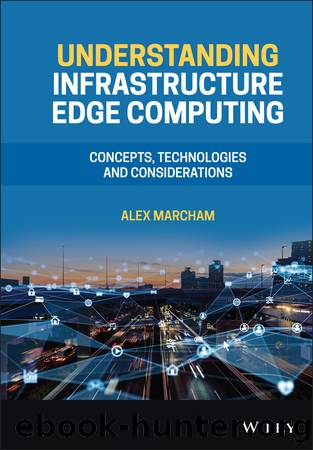Understanding Infrastructure Edge Computing by Alex Marcham

Author:Alex Marcham [Marcham, Alex]
Language: eng
Format: epub
Published: 2021-04-20T00:00:00+00:00
Figure 7.1 Tromboning network traffic path.
Figure 7.2 Direct network traffic path.
Now, in the case where access or last mile network interconnection has been achieved at an edge data centre facility, the resulting network traffic path is direct between the end user and resources located on the infrastructure edge computing network (see Figure 7.2). The resulting physical and logical topology matches the previous diagrams of network traffic flow from earlier chapters. This is what allows the infrastructure edge computing network to provide lower latency and a lower cost of data transport than a regional or national data centre (RNDC) facility and is the only real way to achieve those capabilities.
It is worth reinforcing the importance of this point for the infrastructure edge computing network operator. In an area where there are RNDC facilities which are providing access and last mile network interconnection and the infrastructure edge computing network is not capable of or has not achieved direct interconnection with these networks in one or more edge data centre facilities, there are no use cases or application workloads for which the edge data centre is a better choice than a RNDC facility in terms of either cost or performance. In such a scenario, an IEDC is relegated to the role of expanding capacity for the RNDCs in the area, which in many cases can be achieved at a lower cost to the end user by adding additional data halls to these larger facilities in centralised locations.
As a customer who may deploy equipment within an IEDC, knowing which access or last mile networks are present and interconnected at the infrastructure edge computing network is key to ensuring that any application workloads which are deployed in that facility can be effectively supported without the need for a tromboning traffic path, which wastes time and money. Consider the following factors when analysing a particular infrastructure edge computing network:
Which networks are present in the facility? An infrastructure edge computing network operator should be able to provide on request a list of the networks who are present in the facility and who have agreed that their presence can be publicly known. This allows the customer to understand the network connectivity options which are available at that edge data centre and to distinguish between individual edge data centre facilities within a specific area.
Download
This site does not store any files on its server. We only index and link to content provided by other sites. Please contact the content providers to delete copyright contents if any and email us, we'll remove relevant links or contents immediately.
Grails in Action by Glen Smith Peter Ledbrook(9163)
Sass and Compass in Action by Wynn Netherland Nathan Weizenbaum Chris Eppstein Brandon Mathis(8808)
Azure Containers Explained by Wesley Haakman & Richard Hooper(7436)
Configuring Windows Server Hybrid Advanced Services Exam Ref AZ-801 by Chris Gill(7431)
Kotlin in Action by Dmitry Jemerov(7263)
Running Windows Containers on AWS by Marcio Morales(6976)
Microsoft 365 Identity and Services Exam Guide MS-100 by Aaron Guilmette(5396)
Microsoft Cybersecurity Architect Exam Ref SC-100 by Dwayne Natwick(5205)
Combating Crime on the Dark Web by Nearchos Nearchou(4976)
The Ruby Workshop by Akshat Paul Peter Philips Dániel Szabó and Cheyne Wallace(4665)
Management Strategies for the Cloud Revolution: How Cloud Computing Is Transforming Business and Why You Can't Afford to Be Left Behind by Charles Babcock(4525)
Python for Security and Networking - Third Edition by José Manuel Ortega(4230)
The Age of Surveillance Capitalism by Shoshana Zuboff(4209)
Learn Wireshark by Lisa Bock(4112)
The Ultimate Docker Container Book by Schenker Gabriel N.;(3884)
Learn Windows PowerShell in a Month of Lunches by Don Jones(3681)
DevSecOps in Practice with VMware Tanzu by Parth Pandit & Robert Hardt(3562)
Windows Ransomware Detection and Protection by Marius Sandbu(3539)
Blockchain Basics by Daniel Drescher(3507)
